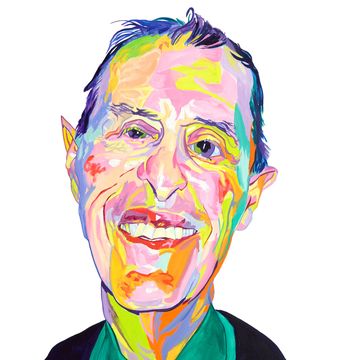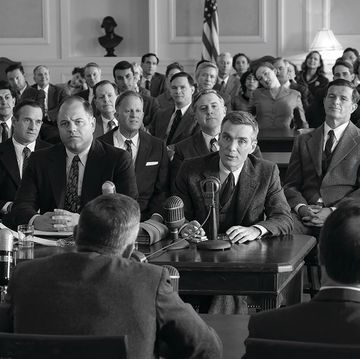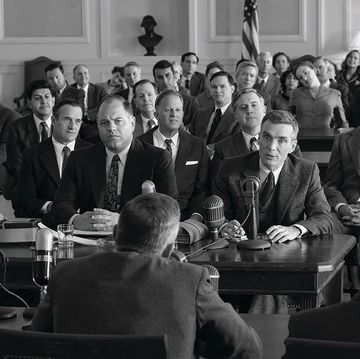You might think you’d just stumbled onto a somehow-forgotten Woody Allen film: Richard Benjamin, best known for his role as the nebbishy Neil Klugman in the film adaptation of Philip Roth’s novella Goodbye, Columbus, and Griffin Dunne, the protagonist in Martin Scorsese’s often-overlooked black comedy After Hours, sitting together in Manhattan’s Walter Reade Theater. They’re waiting for their wives to arrive: Maria (Rosanna Arquette, Dunne’s costar in After Hours) and Eunice (Marcia Jean Kurtz). Peter Pearce (Dunne), a dentist, is trying to convince his father, Simon Pearce (Benjamin), not to divorce Eunice after 65 years of marriage. Why should he further suffer in a sexless union, Simon asks, when he’s got another good 30 years ahead of him? Cut to: Simon and Peter are both divorced and alone in the film’s next transition.
This kind of comic repartee marks the general tenor of director Noah Pritzker’s low-key but charming Ex-Husbands, a tale of marriages and relationships gone (largely) south, we’re convinced, because most men are clueless when it comes to accepting life’s challenges. The main action transpires at a bachelor party for Peter’s son Nick, played by heartthrob James Norton (Greta Gerwig’s Little Women). Through a coincidence that’s justified by nonrefundable plane and hotel reservations, Peter winds up in the same Mexican city as Nick and his band of bros. Needless to say, Peter becomes firmly ensconced in the weekend’s activities, which are considerably tamer than what we’ve come to expect from movies like The Hangover. On the plane to Mexico, Peter’s other son, Mickey (Miles Heizer)—who’s recently come out and appears to be the most grounded of the Pearce clan—says to his seatmate, Arroyo (Pedro Fontaine), “There’s nothing more excruciating than a living parent.” By the end of the film, this sentiment seems largely expiated; father and sons get to a point of shared understanding. Along the way, there are some genuinely funny moments, as when Arroyo, who’s married to a woman, ticks off to Mickey his grocery list of homosexual experiences and delivers what is possibly the best line in the film: “Not taking SSRIs in the 21st century is kind of like not having an iPhone.” There’s also a severed hand, but you’ll have to see the picture to get that gag.
Directors will often tell you that all casting is typecasting, which is to say that you want to find the actor whose own personality—warts and all—mimics that of the character as written. It’s the heavy lifting at which the director must excel. In this regard, Pritzker, who both wrote and directed Ex-Husbands, has done a masterful job. Dunne and Benjamin perfectly inhabit their characters of neurotic paterfamilias. When Peter runs into a former client (John Ventimiglia), he wants to quickly check the man’s teeth. Old habits die hard.
That’s not to say that Pritzker didn’t let some golden opportunities slip through his creative fingers. I kept hoping there’d be at least one scene that made some cryptic reference to the slapstick relationship between Dunne and Arquette in After Hours, but it never came. And the almost continuous and fairly lugubrious score became tedious at best.
Throughout the film, there’s a poster from Ernst Lubitsch’s classic screwball comedy To Be or Not to Be that keeps falling off walls—first in Simon’s room, later in Peter’s sparsely furnished postdivorce apartment. That 1942 piece of filmmaking genius, about an acting troupe in Nazi-occupied Warsaw, was made by a Jewish man just as the United States was entering World War II.
I think the poster’s prominence in Ex-Husbands is meant to suggest that great cinema in this country is broken. Quite literally, theaters have come crashing down. Anora director Sean Baker pointed out in one of his several acceptance speeches at the recent Academy Awards that more than 1,000 screens in the United States have gone dark since the start of the pandemic, and more and more people are streaming at home. It’s encouraging to see Pritzker, a San Francisco native, and Dunne, an Alta Journal contributor, not only adding to the indie-film canon but also out touting their work with Q&A screenings at the Laemmle in Santa Monica and the Opera Plaza in San Francisco. The reality is that independent film would be dead without little theaters like these, and that would be a very sad ending to an art form that started here in California, became this country’s most popular entertainment medium, and spread around the globe as perhaps our greatest export.•
Tom Zito is a serial entrepreneur. He came to California to report a piece on startups for the New Yorker, but launched a company instead. In addition to the New Yorker, he has written for the Washington Post, Esquire, Rolling Stone, Playboy, Cosmopolitan, Life, Newsweek, and many other publications, and has started eight companies.











